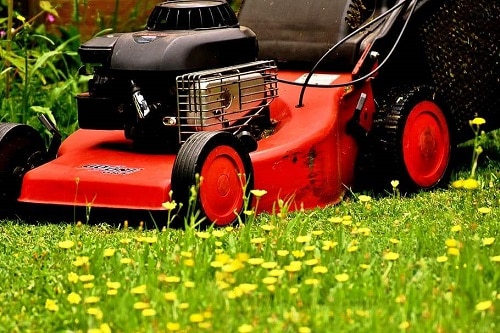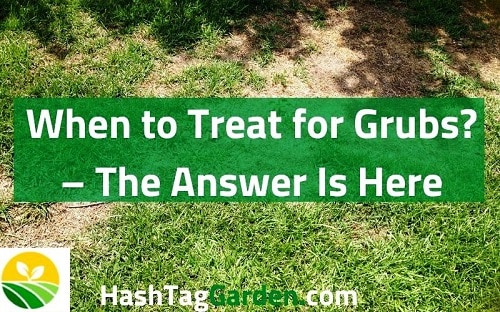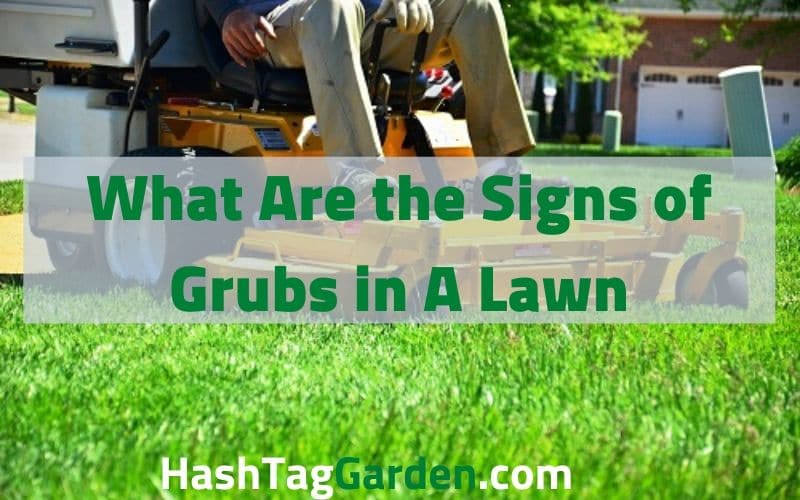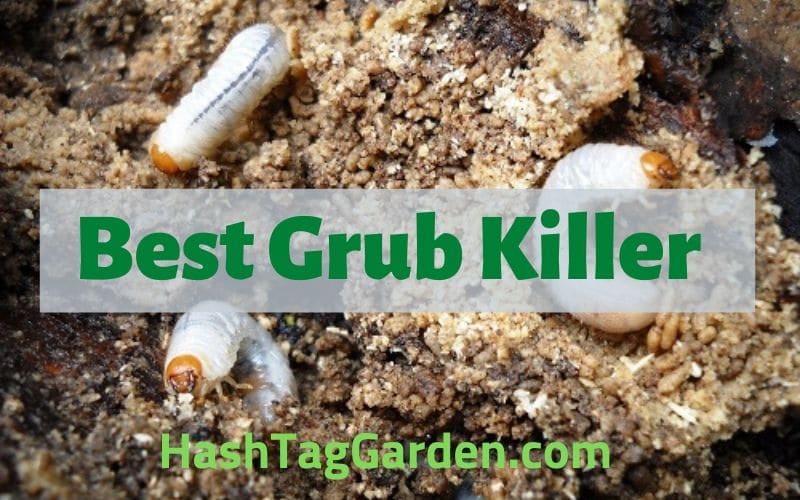Vegetable gardening is not something that you have to take it professionally or going for it with a plan. Anyone can do it in the lawn or his backyard, and if you have one then you must have faced the grubs. Grubs in a vegetable garden are a common issue and we are going to discuss how it forms and also the prevention.
It is the white or grey creature that eats up the roots of your vegetable plants. They are very small in size and one of the common pests that your garden may have. If you see grubs in vegetable garden soil, then there is nothing to worry much as this article will give you the way to get rid of those.
Though the grub problem is very usual, it will not come to your concern until the situation gets serious. So, controlling different grubs in the garden is wise for you before the condition gets out of hand.
| Grub Type | Description | Damage | Prevention | Control |
|---|---|---|---|---|
| Japanese Beetle Grubs | White, C-shaped larvae with brown heads | Feed on roots of grasses, vegetables, and flowers | Use nematodes, milky spore disease, or beneficial nematodes in the soil | Apply insecticides containing carbaryl or trichlorfon |
| June Beetle Grubs | White, C-shaped larvae with brown heads | Feed on roots of grasses, vegetables, and flowers | Remove infested plants, use nematodes or beneficial nematodes in the soil | Apply insecticides containing carbaryl or trichlorfon |
| Rose Chafer Grubs | White, C-shaped larvae with brown heads | Feed on roots of vegetables and flowers | Handpick adults, use nematodes or beneficial nematodes in the soil | Apply insecticides containing carbaryl or trichlorfon |
| Wireworms | Thin, brownish-yellow larvae with hard, shiny bodies | Feed on roots of vegetables and fruits | Rotate crops, keep soil moist, use nematodes or beneficial nematodes in the soil | Apply insecticides containing imidacloprid or clothianidin |
| Cutworms | Dark brown or grayish-black larvae | Cut seedlings at soil level | Use collars around plants, handpick, use nematodes or beneficial nematodes in the soil | Apply insecticides containing carbaryl or spinosad |
What is Grub Worm in Vegetable Garden?
Many people call these grubs as worms but they are not exactly a worm. They are a kind of larvae of the Japanese beetle. In other words, you can say them as the babies of the beetles.
You might have an idea about earthworms and their characteristics as they work as a fertilizer that helps the vegetable and flowers to grow well. On the other hand, the grub worms ingest the plant roots that make your garden dead. So, you should know how to control grubs in vegetable garden for your good.
Almost every garden has grubs but as long as they are in a small number, your garden doesn’t face any danger. When the eggs of the Japanese beetle breed and turn into larvae then the problem begins as they start to eat the roots of the plants.
If you want to know the risk in a calculative way then you have to figure out the number of worms per square foot. If it is 15-20 grubs then you have to consider it as an alarming situation and if not, then the condition is still tolerable.
Types of Grubs Found in Vegetable Garden
Japanese Beetle Grub
The Japanese beetle grub is the larvae stage of the Japanese beetle, which is destructive to vegetable gardens. The grub has a white body with a brown head and measures about 1 inch in length.
The adult beetle lays eggs in the soil, and once hatched, the larvae feed on plant roots. The damage caused by Japanese beetle grubs can be significant.
They can kill entire plants or cause stunted growth, wilting, and reduced yield. If left unchecked for too long, they may even attract other pests like raccoons that dig up lawns in search of the grubs.
Control measures for Japanese beetle grubs include cultural practices like crop rotation and handpicking adult beetles from plants in early morning when they are less active. Chemical control options include applying insecticides containing carbaryl or imidacloprid to targeted areas at specific times during the season when beetles are active.
June Beetle Grub
June beetle grubs are another type of destructive grub found in vegetable gardens. They have a similar appearance to Japanese beetle grubs but are slightly larger and have a C-shaped body with six legs near their head.
They can grow up to 1 1/4 inches long and have a cream-colored body with a darker head. Like other types of grubs, June beetle grubs feed on plant roots causing significant damage to vegetables such as corn, beans, squash, melons and tomatoes; leading to poor crop development or death of affected plants.
Control measures for June beetles include physical removal by handpicking from soil . Applying beneficial nematodes , which attack these beetles at their larval stage before they emerge as adults; it’s recommended that you apply nematodes often since they do not survive for long in the soil.
Similarly, pest exclusion netting can also be placed over plants to prevent adult beetles from laying eggs on the soil near plants. Chemical control methods can also be applied using insecticides containing carbaryl and imidacloprid when timed appropriately during beetle activity periods.
The Life Cycle of a Grub
Grubs go through several stages during their life cycle, from the egg stage to the adult stage. Understanding the different stages of a grub’s life cycle is crucial to managing and controlling them effectively.
The Egg Stage
The egg stage typically lasts for two weeks and begins in mid-summer. The eggs are laid by adult beetles near plant roots, and within a few days, they hatch into larvae or grubs.
The Larvae Stage
The larvae stage is the most destructive phase of the grub’s life cycle. This stage can last for up to four years depending on the type of beetle species.
During this stage, grubs molt several times as they grow larger in size. As they continue to feed on plant roots, their damage becomes more severe and can lead to wilting and stunted growth of plants.
The Molting Process
Molting is a process where grubs shed their exoskeleton as they grow larger in size during their larval stage. They will molt three or four times before reaching pupation or adulthood.
Food Consumption and Damage to Plants
Grubs consume large amounts of roots during their larval stage causing serious damage that impacts plant growth, fruiting capacity, and overall health.
Behavioral Characteristics
Grubs’ behavioral characteristics include moving deeper into soil at night-time which makes them difficult to detect during daylight hours when most gardeners work on their plants.
Duration and Timing of Larval Stage
Timing for each beetle species varies between 1 – 5 years depending on local climatic conditions such as temperature, humidity levels etc., making it difficult for growers to plan effective control measures.
Pupal Stage & Adult Stage
After the larval stage, grubs move onto the pupal stage, which lasts for a few weeks to months. In this stage, they transform into an adult beetle. Depending on the beetle species, the adult stage can last anywhere from a few days to several weeks.
Adult beetles emerge from pupal cases and mate during early summer or fall. Understanding each of these stages of a grub’s life cycle is important for managing them effectively; it helps in deciding which control measure to use and when to apply them.
What Are the Signs of Grubs?
Having a garden means you have to take care of it and beware of all kinds of pests. Grub worms are also pests and can make real damage to your vegetable garden. If your garden is on the lawn, then the best is to check the whole lawn area as grubs can reach your garden easily.
If you have grubs in your lawn or garden, the following signs might appear as a confirmation.
- Grass, plants, or leaves are dying without proper reason.
- Pests like armadillos, moles, or others are appearing in your lawn.
- Grounds becoming spongy day by day.
- Plants are losing leaves continuously.
- Group of grasses changing its color to gray or brown.
- Lose grasses all over and uprooting automatically.
These are the primary signs of grubs and you should take necessary actions if these appear.
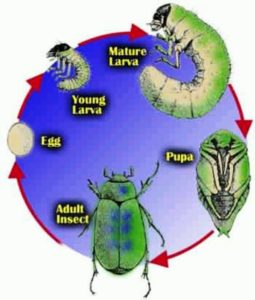
How Grub Worms Forms and their Life Cycle
It is the summer season when beetles lay their eggs. After breeding the eggs, the grub worm forms. Now the worms make their way deep into the ground and find the plants, most importantly the roots. Till winter or fall, they take the roots to feed themselves. This continues as a cycle and there might be no end to it.
Now the main problem is when these worms will get mature and turn into beetles. So, they will again lay eggs in summer and by the time more worms will grow. If the process continues a few times, there will be full of lawn grubs in your vegetable garden.
Getting Rid of Grub Worms – How Necessary It Is?
It will not take much time for the grub worms to from and develop them in a mature condition. So, when the time comes to feed, they choose the plant roots. It is important to control grubs in the vegetable garden and you should take proper action at the right time.
- Roots are very important for the plants to grow as the main job of the roots is to supply water and other necessary components from the ground. So, if the root is damaged then the supply of water and nutrients will be hampered.
- If there is a lack of water and other elements then the function of the plants will be disturbed. This will make an impact on the growth of the plants.
- Besides plant damage, other animal or pets can get affected by grub worms. Anything that relies on grass or lawn plants for their feeding, grub worms will attack them indirectly.
- Some other creatures are helpful for your garden as they eat grubs but it can also do some damage to your garden as they leave burrows.
The bad side of grubs is many. So, you should get rid of them to develop a healthy vegetable garden.
How to Get Rid of Grubs?
We mentioned before that the beetles lay eggs. So, you have to aware of the time or period when the beetles of your area have started laying. After knowing that period, you can buy pesticides from the market and use them.
The pesticides can be a good solution but you have to think twice about it if the garden is in your lawn or in the backyard. Moreover, if you have children in your house then our advice is not to go for pesticides. As toxin level is high in it, it can be dangerous for children and kids.
So, is not there any way to remove the grub worms or green grubs from vegetable garden? Perhaps the natural way is the wisest option to go or you can read our article about grub killer to find the ultimate solution.
The Natural Solution
The natural solution is the safest option for you and the best answer to what kills grubs in vegetable garden. Let’s take a look at the steps and the ways.
- For grub worms, the beneficial nematodes are very effective. Buy it from any general store and spray all over your garden or lawn. They will kill all the pests and left almost nothing. But they work for young larvae only.
- Another natural way to kill curl grubs from garden is by using milky spore (check price on Amazon). It can keep your garden safe for almost 10 years.
- To make the condition better of damaged roots you should keep your garden watered. By absorbing water, the roots can regain its previous state.
- Grub worms are favorite foods to songbirds like Robinson and others. If you have them in your garden, then you do not have to worry much about pests. This is one of the best solutions you may apply.
Grub worms can cause serious damage to your garden especially if you have a vegetable garden. Instead of pesticides, natural solutions are more effective and safer. Moreover, you do not have to worry about any contamination. So, apply the method you prefer and enjoy gardening.
Verdict
Grubs are small pests that are responsible to cause damage to your vegetable garden. It takes a season to mature itself and will silently hamper the plants by eating the roots. Moreover, it will leave your beautiful garden in a brown and unattractive condition.
After plants, other pets or animals will be affected because of their presence. So, you have to aware of this small creature and take steps to save your garden from it.
No matter you already have a vegetable garden or planning to make one, this article will bring favor to you. We have discussed well how grubs form and how they act. The preventions, as well as the solutions, are also in it. All we want is that your plants grow without any strike by grubs.
